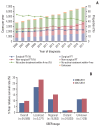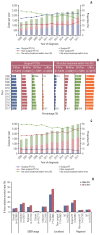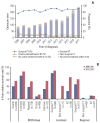First Course of treatment and Prognosis of Exocrine Pancreatic Cancer in Korea from 2006 to 2017
- PMID: 34030432
- PMCID: PMC8756130
- DOI: 10.4143/crt.2021.421
First Course of treatment and Prognosis of Exocrine Pancreatic Cancer in Korea from 2006 to 2017
Abstract
Purpose: Hospital-based clinical studies have limitations in holistic assessment of cancer treatment and prognosis, as they omit out-of-hospital patients including elderly individuals. This study aimed to investigate trends in initial treatment and corresponding prognosis of patients with exocrine pancreatic cancer (EPC) in Korea.
Materials and methods: The Korea Central Cancer Registry data of patients with EPC from 2006 to 2017 were retrospectively reviewed. We defined the first course of treatment (FT) as the cancer-directed treatment administered within four months after cancer diagnosis according to the Surveillance, Epidemiology, and End Results (SEER) program.
Results: Among 62,209 patients with EPC, localized and regional (LR) SEER stage; patients over 70 years old; and ductal adenocarcinoma excluding cystic or mucinous (DAC) accounted for 40.6%, 50.1%, and 95.9%, respectively. "No active treatment" (NT, 46.5%) was the most frequent, followed by non-surgical FT (28.7%) and surgical FT (22.0%). Among 25,198 patients with LR EPC, surgical FT increased (35.9% to 46.3%) and NT decreased (45.0% to 29.5%) from 2006 to 2017. The rate of surgical FT was inversely related to age (55.1% [< 70 years], 37.3% [70-79 years], 10.9% [≥ 80 years]). Five-year relative survival rates of LR DAC were higher after surgical FT than after NT in localized (46.1% vs. 12.9%) and regional stage (23.6% vs. 4.9%) from 2012 to 2017.
Conclusion: Less than half of overall patients with LR EPC underwent surgical FT, and this proportion decreased significantly in elderly individuals. Clinicians should focus attention on elderly patients with EPC to provide appropriate medical advice.
Keywords: Pancreatic neoplasms; Registries; Survival rate; Therapeutics.
Conflict of interest statement
Conflict of interest relevant to this article was not reported.
Figures



Similar articles
-
Conditional Relative Survival of Exocrine Pancreatic Cancer: A Population-Based Study.Ann Surg Oncol. 2024 Feb;31(2):1178-1189. doi: 10.1245/s10434-023-14594-x. Epub 2023 Nov 30. Ann Surg Oncol. 2024. PMID: 38032467
-
Characteristics and Outcomes of Pancreatic Cancer by Histological Subtypes.Pancreas. 2019 Jul;48(6):817-822. doi: 10.1097/MPA.0000000000001338. Pancreas. 2019. PMID: 31210663
-
Pancreatic Acinar Cell Carcinoma: Demographics, Treatment, and Survival Outcomes, A Retrospective Population-Based Study.J Gastrointest Cancer. 2025 Apr 23;56(1):106. doi: 10.1007/s12029-025-01233-9. J Gastrointest Cancer. 2025. PMID: 40266404
-
AGA Clinical Practice Update on Pancreas Cancer Screening in High-Risk Individuals: Expert Review.Gastroenterology. 2020 Jul;159(1):358-362. doi: 10.1053/j.gastro.2020.03.088. Epub 2020 May 19. Gastroenterology. 2020. PMID: 32416142 Review.
-
Mixed exocrine-endocrine pancreatic carcinoma in childhood.Indian J Gastroenterol. 2005 May-Jun;24(3):116. Indian J Gastroenterol. 2005. PMID: 16041106 Review.
Cited by
-
Incidence, mortality and survival of gallbladder, extrahepatic bile duct, and pancreatic cancer using Korea central cancer registry database: 1999-2019.Ann Hepatobiliary Pancreat Surg. 2022 Aug 31;26(3):220-228. doi: 10.14701/ahbps.22-041. Epub 2022 Jul 29. Ann Hepatobiliary Pancreat Surg. 2022. PMID: 35909086 Free PMC article.
-
Three-year follow-up study reveals improved survival rate in NSCLC patients underwent guideline-concordant diagnosis and treatment.Front Oncol. 2024 May 28;14:1382197. doi: 10.3389/fonc.2024.1382197. eCollection 2024. Front Oncol. 2024. PMID: 38863625 Free PMC article.
-
Surgical management for elderly patients with pancreatic cancer.Ann Surg Treat Res. 2023 Aug;105(2):63-68. doi: 10.4174/astr.2023.105.2.63. Epub 2023 Aug 1. Ann Surg Treat Res. 2023. PMID: 37564946 Free PMC article. Review.
-
Conditional Relative Survival of Gallbladder Cancer: A Population-Based Study in a High-Incidence Asian Country from 1999 to 2021.Ann Surg Oncol. 2025 Sep;32(9):6272-6282. doi: 10.1245/s10434-025-17237-5. Epub 2025 Apr 7. Ann Surg Oncol. 2025. PMID: 40192994
-
Trend Analysis and Prediction of Hepatobiliary Pancreatic Cancer Incidence and Mortality in Korea.J Korean Med Sci. 2022 Jul 18;37(28):e216. doi: 10.3346/jkms.2022.37.e216. J Korean Med Sci. 2022. PMID: 35851861 Free PMC article.
References
-
- The Global Cancer Observatory Cancer today; pancreas (C25) [Internet] Lyon: International Agency for Research on Cancer; c2020. [cited 2021 Mar 5]. Available from: https://gco.iarc.fr/today/data/factsheets/cancers/13-Pancreas-fact-sheet... .
-
- National Comprehensive Cancer Network . NCCN clinical practice guidelines in oncology: pancreatic adenocarcinoma, version 2, 2021 [Internet] Plymouth Meeting, PA: National Comprehensive Cancer Network; c2021. [cited 2021 Mar 5]. Available from: https://www.nccn.org/professionals/physician_gls/pdf/pancreatic.pdf . - PubMed
-
- Khorana AA, McKernin SE, Berlin J, Hong TS, Maitra A, Moravek C, et al. Potentially curable pancreatic adenocarcinoma: ASCO clinical practice guideline update. J Clin Oncol. 2019;37:2082–8. - PubMed
-
- Ducreux M, Cuhna AS, Caramella C, Hollebecque A, Burtin P, Goere D, et al. Cancer of the pancreas: ESMO clinical practice guidelines for diagnosis, treatment and follow-up. Ann Oncol. 2015;26(Suppl 5):v56–68. - PubMed
-
- Lutfi W, Zenati MS, Zureikat AH, Zeh HJ, Hogg ME. Health disparities impact expected treatment of pancreatic ductal adenocarcinoma nationally. Ann Surg Oncol. 2018;25:1860–7. - PubMed
MeSH terms
Grants and funding
LinkOut - more resources
Full Text Sources
Other Literature Sources
Medical
Research Materials

